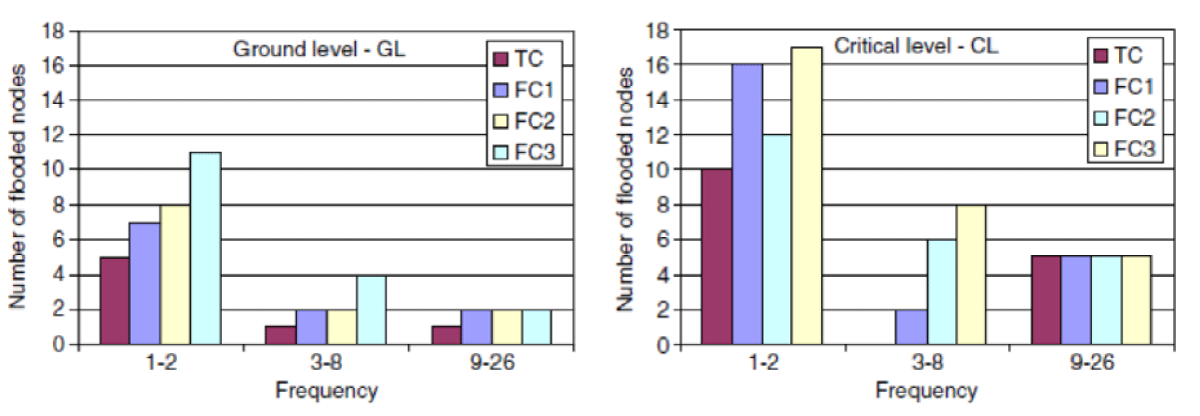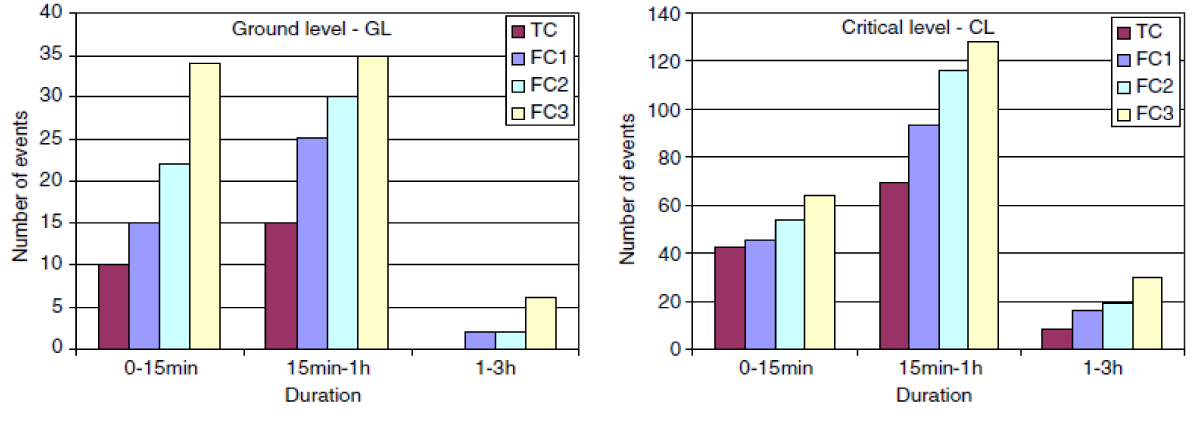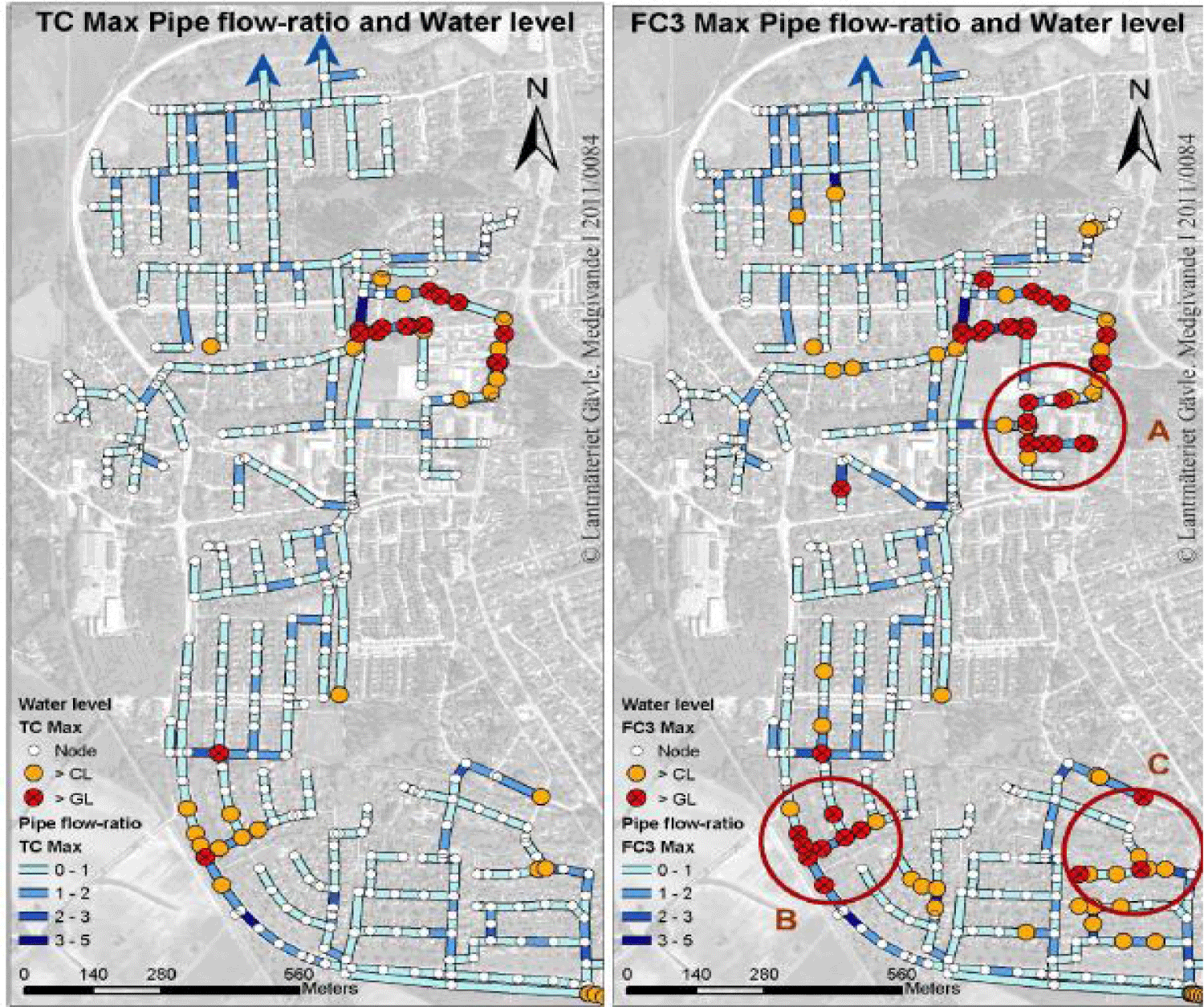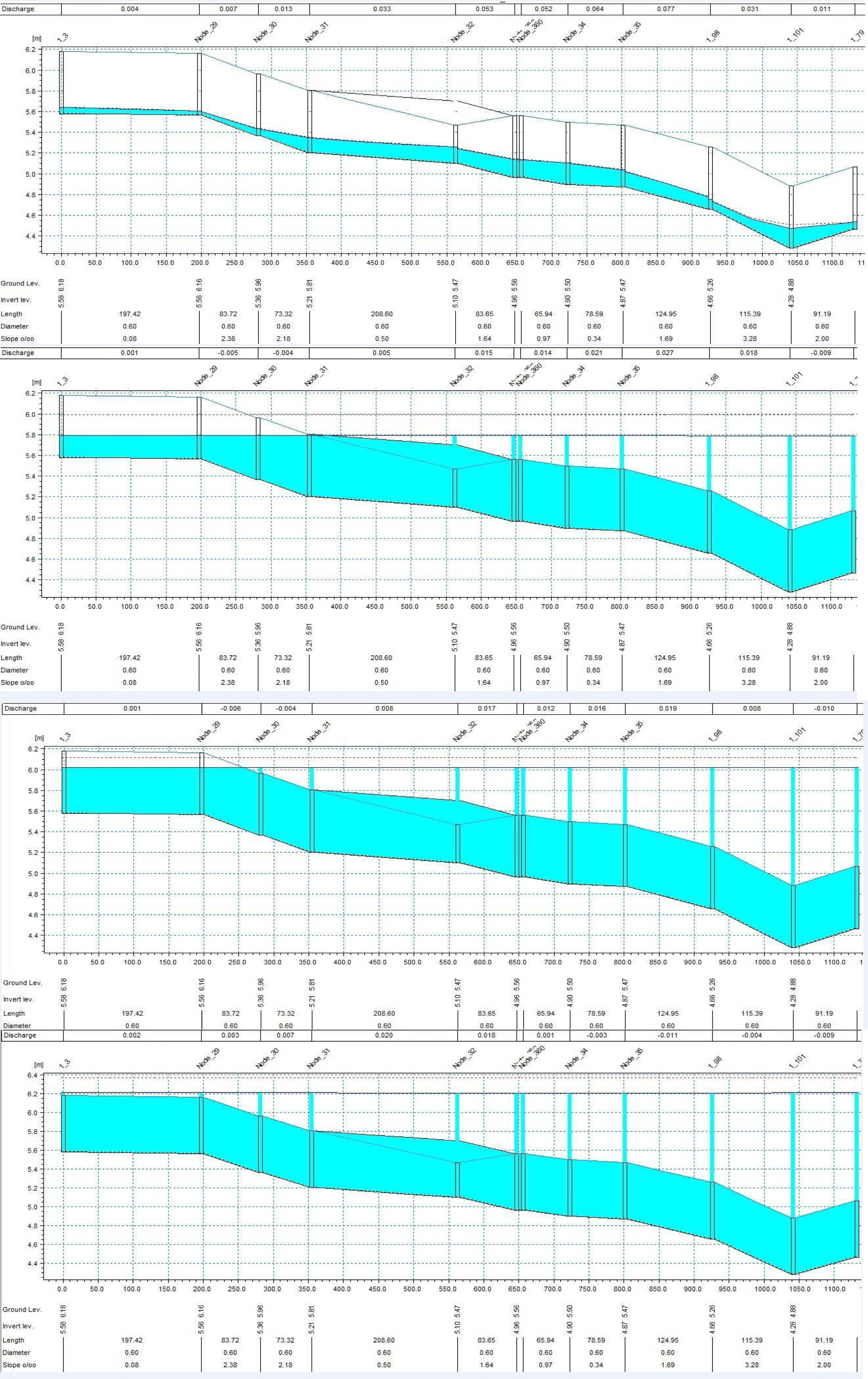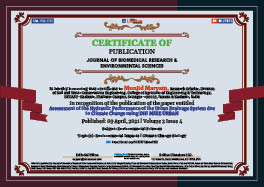> Environmental Sciences. 2021 Apr 09;2(4):261-267. doi: 10.37871/jbres1222.
Assessment of the Hydraulic Performance of the Urban Drainage System due to Climate Change using DHI MIKE URBAN
Munjid Maryam1*, Rohitashw Kumar2 and Namera Thahaby3
2Associate Dean and Professor, College of Agricultural Engineering & Technology, SKUAST-Kashmir, Shalimar Campus, Srinagar-190025, Jammu & Kashmir, India
3PhD Scholar, Division of Veterinary and Animal Husbandry Extension, Faculty of Veterinary Science and Animal Husbandry, SKUAST-Kashmir, Shuhama Campus, Srinagar-190006, Jammu & Kashmir, India
- MIKE URBAN
- Climate change
- Hydraulic performance
- Urban drainage
Abstract
Changes in climate, waterlogging hazards and regional floods are more prominent in present context. The paper reviews potential of flood hazard in dense urban areas, using GIS-based 1-D hydrodynamic model (MIKE URBAN). The major factor contributing to the urban waterlogging in recent decades is the climatic variability and thus the long-term variations of precipitation and drainage system of an urban area were evaluated. MIKE URBAN (1-D) hydrodynamic model can be used to comprehensively simulate inundation processes. The model simulates the processes of rainfall and runoff, urban drainage, and flooding. MIKE URBAN can be used to appraise the potential immersion dangers of any planned drainage system. This paper reviews the increasingly urban flooding events expected in the future for the different cities across the globe. Thus, the surface runoff processes of cities need to examine the regional drainage system.
Introductıon
The attention to the degree to which change of climate can influence the earth, society, and economy is increasing. Long run global climate change has been seen at the mainland, territorial, and sea bowl scales, because of expanding convergence of ozone harming substances especially carbon dioxide. These include changes in precipitation sums and timings, cold temperatures, wind patterns, and parts of extraordinary climate like substantial precipitation, dry spell, and heat waves [1].
The kind of precipitation throughout the winter season can change due to increasing worldwide normal air and sea temperature [1]. In Northern areas and hilly territory, the pattern of precipitation is changing from snow to rain and thus the substantial precipitation occasions have increased even in places where total downpour amounts have diminished. All of these progressions are related to increasing worldwide temperature since hotter air can hold and convey more water vapour.
Expanding urban regions is the foremost striking change observed and identified with the urban and hydrological framework. By 2050, it is anticipated that 67% of the world population is expected to be living in urban territories, with the fastest degrees of urbanization occurring in developing nations. The degradation of natural quality, including the nature of water, air and commotion is often legitimately connected to urbanization. Concurrently, the climate is also changing. Together, the negative effects of global climate change and urbanization present critical difficulties, particularly in developing nations where assets to alleviate these effects are constrained [2].
The development in artificial surfaces which causes an extension in flooding recurrence due to poor infiltration and reduction of stream obstruction (because of quicker concentration times) is primarily the cause of urbanization. The hydro-meteorological changes driven by urbanization, and coming out effects of phenomenal precipitation, are furthermore being developed. A great deal of research throughout the last twenty years shows a strong association between urban regions and nearby microclimate. The “Urban Heat Island” (UHI) impact is presently entrenched, whereby urban regions have higher temperatures than encompassing areas. As a rule, UHI can increment the precipitation in the region of the urban areas. Different assessments have found an extension in precipitation in areas downwind of urban zones, with increments as high as 25% now and again [3].
Worldwide climate change and the expansion of impervious urban surfaces cause expanding precipitation intensities which have put heavier loads on existing drainage systems. Outrageous outcomes through flooding and consolidated sewer overflow can be seen [4].
For quite a while, urban drainage systems have existed as a vital city infrastructure to collect and convey stormwater and wastewater away from urban areas [5,6]. Despite advancement over the years, it stays a critical challenge to design and plan an effective functioning drainage system. Specifically, impacts because of climate change and urbanization have been generally recognized, which could involve a substantial increment in the recurrence and extent of urban flooding in numerous regions of the world [3,7,8]. Simultaneously, water quality issues likewise rise because of urbanization that builds the assortments and measure of toxins and nutrients in receiving water bodies [9-11].
Parameters depicting impacts on urban drainage systems from global climate change and changes in precipitation have concentrated on the number of floods and influenced properties [12], the number of surcharged pipes and changes in runoff volume [7,13], discharge [14] and flood volumes [15].
Rainstorm waterlogging on account of plenitude surface overflow and lacking limit of storm sewer systems is one of the most progressive and genuine typical threat in numerous large urban areas around the globe, particularly those subjected to frequent heavy precipitation. Such events can introduce issues for urban areas experiencing quick urbanization where land surface attributes have been changed in manners that favour increased surface runoff. The volume and stream rate may surpass the limit of existing storm sewer systems, prompting increasingly frequent surcharging, surface flooding, property harm, and traffic disturbance. Even though immersion depths realized by waterlogging are for the most part shallower contrasted with those brought about by fluvial or waterfront floods, the harm and disturbance can be substantial. It isn’t just during urbanization that a city could be antagonistically influenced by waterlogging. Rainstorm waterlogging may likewise pose widespread issues for developed cities with well-established sewer systems. For instance, it was accounted for that most of the 2007 floods in the UK started from over-burden rainstorm sewer in developed territories, and among those structures affected; around 25% were built during the past 25 years [16].
In this way, this paper underscores the hydraulic performance of the urban drainage system. The general objective is to review the hydraulic impacts on the urban drainage systems because of changes in precipitation intensity from global climate change. Further, this paper exhibits the utilization of hydraulic parameters to give a progressively enhanced perspective on urban drainage systems’ vulnerability and capacity.
Model Description
Danish Hydraulic Institute (DHI) is the world’s leading software developers for modelling water resources related time series data.
MIKE URBAN is one of the most adaptable frameworks of DHI and is used extensively for modeling and design of collection systems and water distribution systems for water and stormwater. One of the modules of MIKE URBAN is MOUSE (Modeling of Urban Sewers) which can be used for simulations of unsteady flows in pipe networks. The basic fundamental one-dimensional equation or the “Saint Venant’ equations are primarily solved for calculations in this model. The generally applied algorithm for solving the equation is the implicit, finite difference numerical method. In multiple connected, branched and looped pipe networks, the executed calculation gives proficient and exact solutions. This model has the speciality to cover all the water networks in any city including water distribution and drainage system.
Mouse sewer and channel flow
The cross-sectional averaged Saint Venant equations that describe the development of the water depth and the discharge Q are used to model the sewer flow and channel flow. An implicit finite difference method is used to solve the two governing equations in MOUSE. The preservation of the mass balance and the compatibility of energy levels in the network nodes are ensured by the numerical scheme of double sweep algorithm [17].
The continuity equation is expressed by:
The momentum equation is derived as:
where,
A: Cross-sectional area of flow, (m2)
Q: Flow rate of any cross-section, (m3/s)
qL: Lateral inflow rate per unit length, (m2/s)
φ: The angle of flow with respect to the x direction
R: Hydraulic or resistance radius, (m)
α: Momentum distribution coefficient
(So-Sf): The friction slope
The runoff from rainfall and dry weather flow contribute the inflow towards the sewer system. The water levels and discharges in the open channels or underground pipe networks are computed by the sewer and channel flow model. The channel flow and sewer flow can be integrated to simulate the rainfall-runoff process for specific sites, such as urban-rural transition areas. The exchange of data can be either sequential or simultaneous.
Overland flow in mouse
Overland flow usually occurs when the intensity of rainfall is so high that the runoff is larger than the drainage design capacity. This process of dam breaks provides an analogy to this process; therefore, the 2D shallow water equations are used directly [17].
where,
u: is the velocity in the x direction (m/s),
v: is the velocity in the y direction (m/s),
h: is water depth (m),and
cf: is the roughness
Evaluating the hydraulic response and performance of the urban drainage system
Numerous researches have been carried out to evaluate the hydraulic response and performance of the urban drainage system under changing climate by the use of the Danish Hydraulic Institute’s MIKE URBAN model. Some of them have been reviewed as under.
Water level in nodes
The quantity of the floods, the recurrence and length of floods in the nodes of the drainage system is given by the water level in the nodes. The water levels in nodes were estimated as most extreme from both a Ground Level (GL) and an alleged Critical Level (CL) point of view, where GL and CL can or cannot be surpassed. Beneath the GL, the CL was set at 0.5 m. To portray the contrasts between the simulated periods, the greatest water level was utilized essentially and was statistically compared within matched pairs of nodes. The number of nodes overflowed where water surpassed the Ground Level (GL) in Today’s Climate (TC) expanded for future periods (FC1: 2011–2040, called future climate period 1, FC2: 2041–2070, called future climate period 2, FC3: 2071–2100, called future climate period 3). The number of nodes for which water surpassed the Critical Level in the system (CL) was naturally higher at all periods and expanded from today to future periods. The general propensity was that future precipitation increments both the number of nodes flooded and the flooding recurrence [18] (Figures 1,2).
Pipe flow ratio
The ratio of the actual flow rate and the flow rate when the pipes were running full (not pressurized) in the system is called the pipe flow ratio. For gauging the pipe flow ratio more than once per link, dependent upon the lengths of the pipes, the MIKE URBAN model can be used. Pipe flow ratios for the most extreme flow give more data about system capacity limit and the nodes for which water surpassed the GL and CL. Floods happened primarily in two spots for today’s climate TC, whereas in future period FC3, floods will have spread over a more extensive zone and to different areas also (Figure 3). The new issues will happen later on in the future in the three circles shown in areas (A, B and C). The maximum pipe flow ratio in the network expanded between the two-time frames. For the link with the most noteworthy value, pipe flow ratio is 4.9 for TC and 5.1 for FC3; however, the fundamental part of the estimating points had values lower than 1, which implies that the pipes were not running full [18].
Surcharge of manholes
The circumstance wherein the sewer passageway and exit are submerged and the pipe is flowing full and under pressure is invariably called as the surcharge of a manhole. For indicating the results, a stretch of the stormwater drainage is taken. There was no flooding at the nodes of the Central Buckingham Canal Watershed, Chennai, under the 5-year storms. Be that as it may, under the 10-year storms the minimum flooding was 0.03 m and the most extreme flooding was 1.11m. However, the minimum flooding was 0.05 m and the most extreme flooding was 1.23 m under the 25-year storms. And again under the 50-year storms, the minimum flooding was 0.19 m and the most extreme flooding was 1.49 m (Figure 4). This points out the fact that further studies on the improvement of the design of the drainage system are required [17].
Typical waterlogging area
When the precipitation increases, the peak runoff, accumulated flow and comprehensive runoff coefficient of sub-catchment zone gradually increase. The comprehensive runoff coefficient was found to be the largest with a value of 0.658 when the return period was twenty years. The surface runoff of the no. 99 sub-catchment was found to be the largest since 6 sub-catchments were consolidated within the waterlogged area. Table 1 presents the values of peak runoff and accumulated flow of runoff during various return periods for the no. 99 sub-catchment. Figure 5 outlines that the waterlogging frequents between the old town and the new residential areas are higher in twenty years return period because the elevation is low and confluence speed is quick and surface flow duration is short. Furthermore, severe waterlogging will be caused by the absence of the drainage capacity in the new and old urban regions in future [19].
| Table 1: Runoff characteristics in different return periods in No. 99 sub-catchment. | |||
| Return Period (Years) |
Peak Runoff (m3/s) |
Maximum Cumulative Quantity (m3) | Comprehensive Runoff Coefficient |
| Three | 3.92 | 19520.9 | 0.665 |
| Five | 4.36 | 24057.1 | 0.656 |
| Ten | 5.20 | 31106.9 | 0.657 |
| Twenty | 5.94 | 384892 | 0.658 |
| Table 2: Total number of pressured pipelines in different return periods. | ||||
| Pressure State | Three Years | Five Years | Ten Years | Twenty Years |
| Fully | 3 | 4 | 4 | 4 |
| Partial | 14 | 16 | 17 | 20 |
| Total | 17 | 20 | 21 | 24 |
Pipeline network load
The simulated results show that in the future the number of pressured pipelines in the drainage networks will increase. In the three year return period, 17 pipelines will be under pressure out of which pipeline no. 3 pipeline would be under full pressure while pipeline no. 14 would be under partial pressure. Similarly, in the twenty-year return period, pipeline no. 4 would be under full pressure while pipeline no. 20 would be under partial pressure. The results obtained points out to the fact that the number of pressured pipelines will increase with the increase in the return period and the pressure and pressured duration also increment in the equivalent pressured pipeline. Due to the intersection of the runoff, the pipelines close by the outlet is subjected to easy constriction. Table 2 presents the number of pressured pipelines in various return periods [19,20].
Conclusion
Waterlogging is the frequently occurring problem in many urban areas around the world. Increase in precipitation amounts causes quick surface runoff which usually exceeds the design capacity of the drainage system and hence causes the problem of waterlogging which harms the structures apart from disruption of the traffic.
DHI’s MIKE URBAN can be effectively used for modeling of urban drainage system. The model can quantitatively evaluate and simulate total unsteady flood propagation with high resolution, considering the processes of rainfall-runoff, sewer flow, channel flow and overland flow in contrast with the customary separate hydrological models or (1-D) hydrodynamic model. The planning, area and profundity of the immersion regions can be followed by this model. The estimation of the flooding process through the upgraded capacities to cope with massive databases that depict the surprisingly heterogeneous attributes in the city areas can be relatively improved with the aid of linking the GIS platform with hydrodynamic models.
The hydraulic parameters assessed give an idea about the hydraulic performance of an urban drainage system. These parameters can also be used to measure the hydraulic impact on the drainage system than simply just the number of flooding occasions on extreme precipitation events.
A comprehension of system limit can be improved by critical level in the system nodes below the ground level. The system limit is improved by the pipe flow proportion and critical areas can be located when introduced graphically.
The paper additionally exhibits that increasingly urban flooding events are to be expected in the future for the various urban communities across the globe and in this way place further pressure on the city’s drainage system. Moreover, during routine maintenance and repair of the drainage system, an additional limit could be introduced to more likely prepare the city for foreseen increments in substantial precipitation and related waterlogging hazard [21].
References
- Solomon D, Qin M, Manning Z, Chen M, Marquis KB, Averyt M, Tignor, Miller. Intergovernmental Panel on Climate Change. Summary for policymakers. Climate change 2007: The physical science basis. Contribution of Working Group I to the 4th Assessment Rep. of the IPCC, S., eds., Cambridge University Press, Cambridge, U.K.
- Cullis J, Horn A, Rossouw N, Jeffes L, Kunneke M, Hoffman W. Urbanization, climate change and its impact on water quality and economic risks in a water scarce and rapidly urbanizing catchment: Case study of the Berg River Catchment. Water Journal. 2019;2(1):146-167. doi:10.2166/h2oj.2019.027
- Huong, T, Pathirana A. Urbanization and climate change impacts on future urban flooding in Can Tho city, Vietnam. Hydrology and Earth System Science. 2013;17:379-394. doi:10.5194/hess-17-379-2013
- Nie L, Lindholm O, Lindholm G, Syversen E. Impacts of climate change on urban drainage systems- a case study in Fredrikstad, Norway. Urban Water. 2009;6(4):323-332. doi:10.1080/15730620802600924
- Chocat B, Ashley R, Marsalek J, Matos MR, Rauch W, Schilling W, Urbonas B. Towards the sustainable management of urban storm-water. Indoor and Built Environment. 2007;16:273-285. doi:10.1177/1420326X07078854
- Larsen TA, Gujer W. The concept of sustainable urban water management. Water Science and Technology. 1997;35(9):3-10. doi: 10.1016/S0273-1223(97)00179-0
- Semadeni-Davies A, Hernebring C, Svensson G, Gustafsson LG. The impacts of climate change and urbanisation on drainage in Helsingborg, Sweden: Suburban stormwater. Journal of Hydrology. 2008;350:114-125. doi:10.1016/j.jhydrol.2007.11.006
- Zhou Q, Mikkelsen PS, Halsnaes K, Arnbjerg-Nielsen K. Framework for economic pluvial flood risk assessment considering climate change effects and adaptation benefits. Journal of Hydrology. 2012;414:539-549. doi: 10.1016/j.jhydrol.2011.11.031
- Arora AS, Reddy AS. Multivariate analysis for assessing the quality of stormwater from different urban surfaces of the Patiala City, Punjab (India). Urban Water Journal. 2013;10:422-433. doi: 10.1080/1573062X.2012.739629
- Hatt BE, Fletcher TD, Walsh CJ, Taylor SL. The influence of urban density and drainage infrastructure on the concentrations and loads of pollutants in small streams. Environ Manage. 2004 Jul;34(1):112-24. doi: 10.1007/s00267-004-0221-8. Epub 2004 May 28. PMID: 15383877.
- Wang J, Da L, Song K, Li BL. Temporal variations of surface water quality in urban, suburban and rural areas during rapid urbanization in Shanghai, China. Environ Pollut. 2008 Mar;152(2):387-93. doi: 10.1016/j.envpol.2007.06.050. Epub 2007 Aug 3. PMID: 17681654.
- Ashley RM, Balmforth DJ, Saul AJ, Blanksby JD. Flooding in the future: Predicting climate change, risks and responses in urban areas. Water Science and Technology. 2005;52(5):265-273.
- Bruen M, Yang J. Combined hydraulic and black-box models for flood forecasting in urban drainage systems. Journal of Hydrologic Engineering. 2006;11:589-596. doi:10.1061/(ASCE)1084-0699(2006)11:6(589)
- Dougherty M, Dymond RL, Grizzard TJ, Godrej AN, Zipper CE, Randolph J. Quantifying long-term hydrologic response in an urbanizing basin. Journal of Hydrological Engineering. 2007;12(1):33-41.
- Niemczynowicz J. Impact of the greenhouse effect on sewerage systems: Lund case study. Hydrological Sciences Journal. 1989;34(6):651-666. doi: 10.1080/02626668909491373
- Wu X, Yu D, Chen Z, Wilby R. An evaluation of the impacts of land surface modification, storm sewer development, and rainfall variation on waterlogging risk in Shanghai. Natural Hazards. 2012;63:305-323. doi: 10.1007/s11069-012-0153-1
- Vidyapriya V, Ramalingam M. Hydraulic flood modeling using MIKE Urban software: An application to Chennai city. International Journal of Pollution Abatement Technology. 2019;1:20-24.
- Berggren K, Olofsson M, Viklander M, Svensson G, Gustafsson A. Hydraulic impacts on urban drainage systems due to changes in rainfall caused by climatic change. Journal of Hydrologic Engineering. 2012;17:92-98. https://doi.org/10.1061/(ASCE)HE.1943-5584.0000406
- Luan Q, Zhang K, Liu J, Wang G, Ma J. The Application of MIKE Urban model in drainage and waterlogging in Lincheng County, China. International Association of Hydrological Sciences. 2018:379-381. doi: 10.5194/piahs-379-381-2018
- Waters D, Watt WE, Marsalek J, Anderson BC. Adaptation of a storm drainage system to accommodate increased rainfall resulting from climate change. Journal of Environmental Planning and Management. 2003;46:755-770. doi: 10.1080/0964056032000138472
- DHI. MIKE URBAN-A modeling system for water distribution and drainage system, User’s Manual, Danish Hydraulic Institute, Horsholm, Denmark. 2012.
Content Alerts
SignUp to our
Content alerts.
 This work is licensed under a Creative Commons Attribution 4.0 International License.
This work is licensed under a Creative Commons Attribution 4.0 International License.





